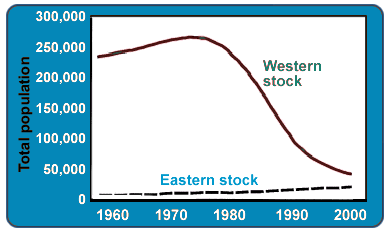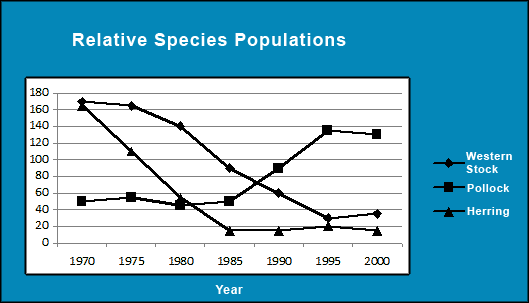|
|
|
Class Sessions
1 | 2 | 3 | 4 | 5 | 6 | 7 | 8 | 9 | 10 | 11 | 12 | 13 | 14
|
Session 12 Case Study One: Mystery
in Alaska:
|
|
http://ruby.fgcu.edu/courses/twimberley/EnviroHealth2/EnviroHealth/environmental_health.htm |
| Below you will find a case study in three parts. Answer the questions posed after each part and post your answers under drop box 12. Cite and reference your answers where necessary and include the questions followed by your answers. |
Part I – West vs. EastStudies conducted by the Alaska Fisheries Science Center of the National Marine Mammal Laboratory have established that Steller sea lions have been disappearing at an alarming rate in Alaskan waters. Since the 1970s, these marine mammals have experienced a severe overall decrease in population, but the decrease has not been uniform. The region from the Prince William Sound through the Aleutian Islands has observed an 85–90% decrease in the abundance of these creatures; this region contains the Western stock of Steller sea lions, as illustrated in Figure 1. The Eastern stock, also seen in Figure 1, is located on the southeast coast of Alaska and its Steller sea lion population is increasing modestly (Figure 2). Figure 1. Distribution (Click for enlargement.) 
Figure 1 courtesy of the Alaska Fisheries Science Center, National Oceanic and Atmospheric Administration (NOAA). Figure 2. Steller Sea Lion Populations 
Estimated numbers of Steller sea lions (all ages) in Alaska from 1956 to 2000 (from Trites & Larkin, 1996; A.W. Trites, unpublished data). Figure used with permission of the North Pacific Universities Marine Mammal Research Consortium. There is particular concern regarding the Western stock of sea lion pups. Most of these juveniles don’t survive more than three years and therefore many do not reach sexual maturity, which occurs in males between 3 to 8 years of age and in females at an average age of 4.6 years (Pilcher, 1981). Because of their small size, the sea lion pups are more vulnerable to changes in their environment and are less able to adapt to these changes. While they have higher energy needs for growth and development, the pups are inexperienced hunters, inefficient at catching prey, and largely dependent on their mothers for survival. Questions
References
Part II – Pollock vs. HerringSteller sea lions are powerful predators, feeding on almost any smaller fish found in their habitat. However, two fish comprise a majority of the sea lions’ diet: pollock and herring. Herring are small schooling fish that can be fed upon in large numbers. Contrastingly, pollock are larger, more solitary, and difficult for the sea lions to catch and digest. In 1970, the Federal government, prompted by environmental groups that argued that the pollock population was declining in western Alaskan waters, introduced a ban on the commercial fishing of pollock from the southwestern coast of Alaska through the Aleutian Islands. This ban altered the western waters’ ecosystem, but left that of the waters along the southeast Alaskan coast largely unchanged. While fish populations in the southeast remained unchanged, relative fish populations in the southwest flip-flopped, with herring becoming less plentiful and pollock more abundant. (A portion of the fish community was salmon, and this remained unchanged with the change in fishing regulations in both the southwest and southeast.) As the ecosystem in southwest Alaskan waters changed, the population of the Western stock of Steller sea lions also changed. A census of the populations of pollock, herring, and the Western stock of Steller sea lions in southwest Alaska disclosed striking trends, which are illustrated in Figure 3. It was also observed that the Western stock exhibited a far higher pup fatality rate than that observed in the Eastern stock (Rosen, 2000). Steller sea lions give birth to a single pup. The age of weaning for pups is variable, ranging from one to three years. While the pups suckle, they do not hunt and are dependent on their mothers for food (Alaska, 2007). The data in Figure 3 show the trends in the relative numbers of pollock, herring, and sea lions (Thorne, 2009). Figure 3. Population Trends 
Graph based on based on Thorne, 2009. Questions
References
Part III – Diet vs. Energy Requirements
© Derek Holzapfel | Dreamstime.com An experiment was conducted at the Vancouver Aquarium Marine Science Centre to compare the relative effects of eating pollock and herring on Steller sea lions (Alaska Fisheries Science Center, 1994). Releasing live, swimming prey for sea lions to chase and capture in two very large tanks simulated the natural habitat of the Steller sea lions. The first group of sea lions was placed in a tank where they preyed upon herring as their only food source. A second sea lion group preyed exclusively on pollock in an otherwise comparable second tank. The sea lions were allowed to eat as much of each of these types of fish as they desired. Those fed herring all gained weight during the course of the experiment while those consuming exclusively pollock all lost weight. This experiment was then extended for the second group. This group’s diet was switched so that they ate strictly herring rather than pollock. Under these conditions, the sea lions reversed their weight loss and experienced a steady weight gain. It was also noted that sea lion pups exhibited the most dramatic weight losses and gains during each of these experiments. The researchers compared the amount of energy available to the Steller sea lions when eating pollock to that available when they fed on herring. Pollock is a lean, low fat fish; it contains 1% fat and 20% protein and 79% carbohydrate. Herring is a fatty fish; it contains 10% fat, 19% protein, and 71% carbohydrate (Donnelly, 2003). It was also found that the larger pollock is a more difficult fish for the sea lions to digest than the smaller herring. This experiment highlighted the importance of meeting energy requirements for marine mammals to live healthy lives. There are three general types of foods from which sea lions obtain energy: fats, carbohydrates, and proteins. Fats contain 9 calories per gram while proteins and carbohydrates afford only 4 calories per gram. To thrive, any species must consume food that provides enough net energy to sustain a healthy body. Calculations
Questions
References
NoteWe have explored only one of the hypotheses that could account for the decline in the Western stock of Steller sea lions. Others exist that could also account for this decline. For example, a climate shift occurring in the region has also been proposed as a contributing cause (see Fritz and Hinkley, 2005). Time considerations prevent us from exploring these alternative proposals.
|
Class Sessions
1 | 2 | 3 | 4 | 5 | 6 | 7 | 8 | 9 | 10 | 11 | 12 | 13 | 14